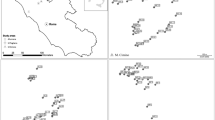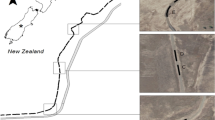Abstract
Estimating demographic parameters in rare species is challenging because of the low number of individuals and their cryptic behaviour. One way to address this challenge is to gather data from several regions or years through mark-release-recapture (MRR) and radio-tracking monitoring. However, the comparison of demographic estimates obtained using these methods has rarely been investigated. Using 5 years of intensive MRR and radio-tracking surveys of an elusive and endangered saproxylic insect, the hermit beetle (Osmoderma eremita), in two regions of France, we aimed to estimate population size at the adult stage for each sex separately and to assess differences in demographic parameter estimates between survey methods. We found that males were approximately three times more likely to be recaptured than females. Taking this into account, we determined that the sex ratio was male-biased in almost all populations, except in Malus trees, where it was female-biased. Temporal fluctuations of sex ratios were also detected in one region. The radio-tracking transmitter (450 mg) allowed only the largest individuals (>2 g) to be targeted. However, we found that, among non-equipped individuals, the larger males survived better than the smaller males. We also confirmed that transmitter-equipped individuals survived approximately 25 % better than non-equipped individuals. Extrapolating the estimates from radio-tracking surveys to the population scale may result in overly optimistic population projections. Our results revealed large temporal and spatial variations in population size and sex ratios. This knowledge is crucial for predicting the persistence of small populations in fragmented landscapes. This study also questioned the representativeness of radio-tracking surveys for insect species in estimating demographic parameters at the population scale.



Similar content being viewed by others
References
Anthony LL, Blumstein DT (2000) Integrating behaviour into wildlife conservation: the multiple ways that behaviour can reduce N e. Biol Conserv 95:303–315
Audisio P, Brustel H, Carpaneto GM, Coletti G, Mancini E, Trizzino M, Antonini G, De Biase A (2008) Data on molecular taxonomy and genetic diversification of the European Hermit beetles, a species-complex of endangered insects (Coleoptera: Scarabaeidae, Cetoniinae, Osmoderma). J Zool Sys Evol Res 47:88–95
Barker RJ (1997) Joint modeling of live-recapture, tag-resight, and tag-recovery data. Biometrics 53:657–668
Boiteau G, Colpitts B (2001) Electronic tags for the tracking of insects in flight: effect of weight on flight performance of adult Colorado potato beetles. Entomol Exp Appl 100:187–193
Boiteau G, Meloche F, Vincent C, Leskey TC (2009) Effectiveness of glues used for harmonic radar tag attachment and impact on survival and behavior of three insect pests. Environ Entomol 38:168–175
Bouget C, Brustel H, Nageleisen L-M (2005) Nomenclature of wood-inhabiting groups in forest entomology: synthesis and semantic adjustments. CR Biol 328:936–948
Burnham KP (1991) On a unified theory for release-resampling of animal populations. In: Chao MT, Cheng PE (eds) Proceedings of 1990 Taipei Symposium in Statistics. Institute of Statistical Science, Academia Sinica, Taipei, pp 11–36
Burnham KP (1993) A theory for combined analysis of ring recovery and recapture data. In: Lebreton J-D, North PM (eds) Marked individuals in the study of bird population. Birkhauser, Basel, pp 199–213
Burnham KP, Anderson DR (1998) Model selection and inference: a practical information theoretic approach. Springer, New York
Conn PB, Bailey LL, Sauer JR (2004) Indexes as surrogates to abundance for low abundance species. In: Thompson WL (ed) Sampling rare and elusive species: concepts, designs, and techniques for estimating population parameters. Island Press, Washington, DC, pp 59–74
Doherty P, White G, Burnham K (2012) Comparison of model building and selection strategies. J Ornithol 152:S317–S323
Drag L, Hauck D, Pokluda P, Zimmermann K, Cizek L (2011) Demography and dispersal ability of a threatened saproxylic beetle: a mark-recapture study of the Rosalia longicorn (Rosalia alpina). PLoS One 6:e21345
Dubois GF (2009) Écologie des coléoptères saproxyliques: Biologie des populations et conservation d’Osmoderma eremita (Coleoptera: Cetoniidae). PhD thesis, Université de Rennes 1, Rennes (in French with English abstract)
Dubois G, Vignon V (2008) First results of radio-tracking of Osmoderma eremita (Coleoptera: Cetoniidae) in French chestnut orchards. In: Vignon V, Asmodé JF (eds) Proceedings of the 4th symposium and workshop on the conservation of saproxylic beetles. Revue d’Ecologie (La Terre et La Vie), Vivoin, pp 131–138
Dubois GF, Vignon V, Delettre YR, Rantier Y, Vernon P, Burel F (2009) Factors affecting the occurrence of the endangered saproxylic beetle Osmoderma eremita (Scopoli, 1763) (Coleoptera: Cetoniidae) in an agricultural landscape. Landsc Urban Plan 91:152–159
Dubois GF, Le Gouar PJ, Delettre YR, Brustel H, Vernon P (2010) Sex-biased and body condition dependent dispersal capacity in the endangered saproxylic beetle Osmoderma eremita (Coleoptera: Cetoniidae). J Insect Conserv 14:679–687
Engen S, Lande R, Sæther BE (2003) Demographic stochasticity and Allee effect in populations with two sexes. Ecology 84:2378–2386
Hedin J, Ranius T (2002) Using radio telemetry to study dispersal of the beetle Osmoderma eremita, an inhabitant of tree hollows. Comput Electron Agr 35:171–180
Hedin J, Ranius T, Nilsson S, Smith H (2008) Restricted dispersal in a flying beetle assessed by telemetry. Biodivers Conserv 17:675–684
Julliard R (2000) Sex-specific dispersal in spatially varying environments leads to habitat-dependent evolutionarily stable offspring sex ratios. Behav Ecol 11:421–428
Lebreton J-D, Burnham KP, Clobert J, Anderson DR (1992) Modeling survival and testing biological hypothesis using marked animals: a unified approach with case studies. Ecol Monogr 62:67–118
Legendre S, Clobert J, Møller AP, Sorci G (1999) Demographic stochasticity and social mating system in the process of extinction of small populations: the case of passerines introduced to New Zealand. Am Nat 153:449–463
Luce J-M (1995) Écologie des cétoines (Insecta: Coleoptera) microcavernicoles de la forêt de Fontainebleau. Niches écologiques, relations interspécifiques et conditions de conservation des populations. Thèse, Muséum National d’Histoire Naturelle, Paris (in French)
Mackenzie DI, Nichols JD, Sutton N, Kawanishi K, Bailey LL (2005) Improving inferences in population studies of rare species that are detected imperfectly: the statistics of rarity. Ecology 86:1101–1113
Oleksa A, Gawronski R (2008) Influence of day time and weather conditions on the activity of the hermit beetle, Osmoderma eremita Scop., and their consequences for monitoring. Parki Narodowe i Rezerwaty Przyrody 27:63–73
Paulian R, Baraud J (1982) Lucanoidea et Scarabaeoidea, Faune des Coléoptères de France, vol 2. Lechevalier, Paris (in French)
Pollock KH, Marsh H, Bailey LH, Farnworth GL, Simons TR, Alldredge MW (2004) Separating components of detection probability in abundance estimation: an overview with diverse examples. In: Thompson WL (ed) Sampling rare and elusive species: concepts, designs, and techniques for estimating population parameters. Island Press, Washington, DC, pp 43–58
Ranius T (2001) Constancy and asynchrony of Osmoderma eremita populations in tree hollows. Oecologia 126:208–215
Ranius T (2006) Measuring the dispersal of saproxylic insects: a key characteristic for their conservation. Popul Ecol 48:177–188
Ranius T (2007) Extinction risks in metapopulations of a beetle inhabiting hollow trees predicted from time series. Ecography 30:716–726
Ranius T, Hedin J (2001) The dispersal rate of a beetle, Osmoderma eremita, living in tree hollows. Oecologia 126:363–370
Ranius T, Aguado LO, Antonsson K, Audisio P, Ballerio A, Carpaneto GM, Chobot K, Gjurasin B, Hanssen O, Huijbregts H, Lakatos F, Martin O, Neculiseanu Z, Nikitsky NB, Paill W, Pirnat A, Rizun V, Ruicnescu A, Stegner J, Süda I, Szwako P, Tamutis V, Telnov D, Tsinkevich V, Versteirt V, Vignon V, Vögeli M, Zach P (2005) Osmoderma eremita (Coleoptera, Scarabaeidae, Cetoniinae) in Europe. Animal Biodiv Conserv 28:1–44
Ranius T, Svensson GP, Berg N, Niklasson M, Larsson MC (2009) The successional change of hollow oaks affects their suitability for an inhabiting beetle, Osmoderma eremita. Ann Zool Fenn 46:205–216
Rink M, Sinsch U (2007) Radio-telemetric monitoring of dispersing stag beetles: implications for conservation. J Zool 272:235–243
Schaffrath U (2003) Zur Lebensweise, Verbreitung und Gefärdung von Osmoderma eremita (Scopoli, 1763) (Coleoptera; Scarabaeoidea, Cetoniidae, Trichiinae), Teil 1 und 2. Philippia 10:157–336 (in German)
Schtickzelle N, Le Boulengé E, Baguette M (2002) Metapopulation dynamics of the bog fritillary butterfly: demographic processes in a patchy population. Oikos 97:349–360
Seger J, Stubblefield JW (2002) Models of sex-ratio evolution. In: Hardy ICW, Hardy I (eds) Sex ratios: concepts and research methods. Cambridge University Press, Cambridge, pp 2–25
Soisalo M, Cavalcanti S (2006) Estimating the density of a jaguar population in the Brazilian Pantanl using camera-traps and capture-recapture sampling in combination with GPS radio-telemetry. Biol Conserv 129:487–496
Svensson GP, Larsson MC, Hedin J (2004) Attraction of the larval predator Elater ferrugineus to the sex pheromone of its prey, Osmoderma eremita, and its implication for conservation Biology. J Chem Ecol 30:353–363
Symonds M, Moussalli A (2011) A brief guide to model selection, multimodel inference and model averaging in behavioural ecology using Akaike’s information criterion. Behav Ecol Sociobiol 65:13–21
Tauzin P (2005) Ethology and distribution of the “Hermit beetle” in France (Coleoptera, Cetoniidae, Trichiinae, Osmodermatini). Cetoniimania 4:131–153
Ulrich W (2007) Body weight distributions of central European Coleoptera. Eur J Entomol 104:769–776
Vignon V, Asmodé J-F, Rapaport P (2005) Heterogeneity of the spatial distribution of Osmoderma eremita (Scopoli) populations in a hedgerow network (France, Normandy). In: Barclay MVL, Telnov D (eds) Proceedings of the 3rd symposium and workshop on the conservation of saproxylic beetles. Latvijas entomologs, Supplementum VI, Riga/Latvia, pp 109–115
White GC (2005) Correcting wildlife counts using detection probabilities. Wildl Res 32:211–216
White GC, Burnham KP (1999) Program MARK: survival estimation from populations of marked animals. Bird Study 46:120–139
Acknowledgments
We owe special thanks to Olivier Martin (ISATIS Environnement), Cédric Doaré, Coralie Le Chatreux, Cécile Grimaldi, Nicolas Lebreton (OGE) for surveying beetles, to Christian Kampichler for English editing and to Valérie Briand for bibliography formatting. We thank the General Council of the Orne Department and the Company Alis for their authorization to use the database carried out by the research consultancy OGE. This work was supported by the prefectural office of the Sarthe department, DIREN Pays de la Loire, General Council of the Sarthe department and Cofiroute. We are very grateful to the two anonymous reviewers for their helpful comments.
Author information
Authors and Affiliations
Corresponding author
Additional information
G. F. Dubois and P. J. Le Gouar equally contributed to the manuscript.
Electronic supplementary material
Below is the link to the electronic supplementary material.
Rights and permissions
About this article
Cite this article
Le Gouar, P.J., Dubois, G.F., Vignon, V. et al. Demographic parameters of sexes in an elusive insect: implications for monitoring methods. Popul Ecol 57, 227–236 (2015). https://doi.org/10.1007/s10144-014-0453-2
Received:
Accepted:
Published:
Issue Date:
DOI: https://doi.org/10.1007/s10144-014-0453-2




